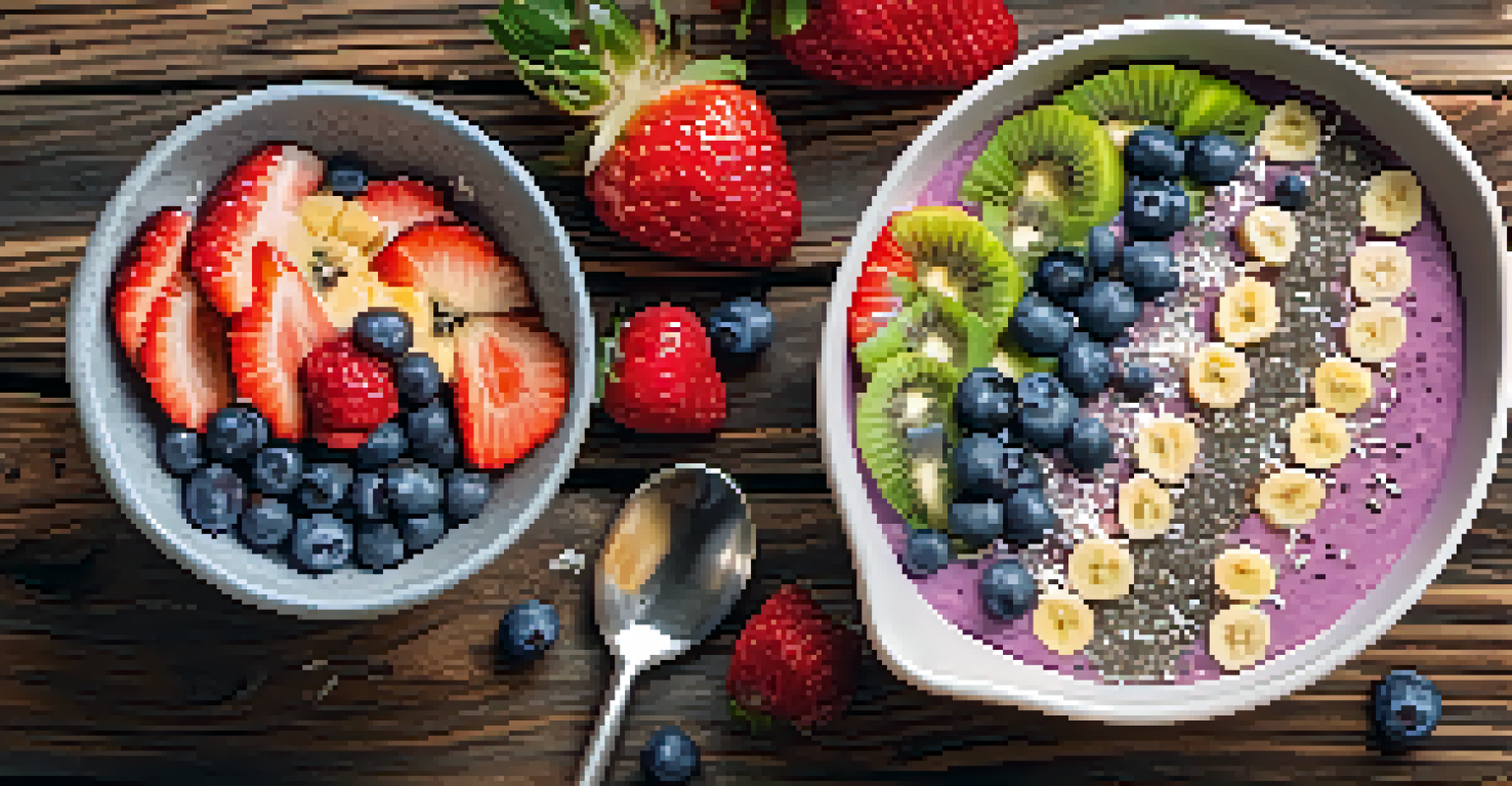The Nutritional Trade-offs of Raw Food and Conventional Diets

Understanding Raw Food Diets: Basics and Benefits
A raw food diet primarily consists of unprocessed, uncooked foods. Advocates believe that cooking can destroy vital nutrients and enzymes that are beneficial for health. The idea is that eating foods in their natural state can lead to better digestion and increased energy levels.
Let food be thy medicine and medicine be thy food.
Common staples in raw food diets include fruits, vegetables, nuts, seeds, and sprouted grains. These foods are typically rich in vitamins, minerals, and antioxidants, making them a nutritious option. Many raw food enthusiasts report improved skin health and weight loss as immediate benefits of this lifestyle.
However, while there are many benefits, it’s essential to consider potential drawbacks. For example, a strict raw food diet may lack certain nutrients, such as vitamin B12 and iron, which are more abundant in cooked foods or animal products. Balancing a raw food diet with nutrient-rich options is crucial for overall health.
Conventional Diets: Structure and Nutritional Value
Conventional diets typically include a mix of cooked and raw foods, focusing on a balance of macronutrients: carbohydrates, proteins, and fats. This flexibility allows for a wider variety of foods, including grains, legumes, meats, and dairy products. Many people find this approach more satisfying and easier to maintain long-term.

Cooking foods can enhance their flavor and digestibility, making it easier for the body to absorb nutrients. For example, cooking tomatoes boosts their lycopene content, a powerful antioxidant. This means that while some nutrients may be lost during cooking, others can actually become more bioavailable.
Raw Food Diet Benefits and Risks
While raw food diets can enhance nutrient intake and promote health, they may also lack essential nutrients and pose food safety risks.
Moreover, conventional diets can be tailored to individual health needs, such as incorporating gluten-free or low-carb options. This adaptability can help people achieve specific health goals, whether it's weight loss, muscle gain, or managing a health condition. However, it’s important to be mindful of processed foods that can diminish the nutritional quality of a conventional diet.
Nutrient Density: Raw vs. Cooked Foods
Nutrient density refers to the amount of essential nutrients per calorie in a food. Raw foods generally have a higher nutrient density due to their natural state. For instance, leafy greens and fresh fruits are packed with vitamins and minerals, making them low-calorie but nutrient-rich choices.
You are what you eat, so don't be fast, cheap, easy, or fake.
On the flip side, some cooked foods, like sweet potatoes and carrots, also have a high nutrient density, but the cooking process can enhance their nutrient availability. This means that while raw foods offer a plethora of nutrients, cooked foods can sometimes provide a more substantial nutrient payoff.
Therefore, it's crucial to consider the overall nutrient profile of your diet rather than solely focusing on whether foods are raw or cooked. A combination of both can help maximize nutrient intake while keeping meals enjoyable and diverse.
Digestibility: Raw Foods vs. Cooked Foods
Digestibility is a key factor in how our bodies absorb nutrients from food. Raw foods, while packed with nutrients, can be harder to digest for some individuals, especially those with sensitive stomachs. The fibrous nature of raw vegetables can lead to bloating or discomfort if consumed in large quantities.
Conversely, cooking foods often breaks down tough fibers, making them easier for our bodies to process. For example, cooking broccoli can help soften its fiber, allowing for better digestion and nutrient absorption. This is especially important for those who may have digestive issues or specific dietary restrictions.
Conventional Diet Flexibility
Conventional diets offer a balance of macronutrients and can be tailored to individual health needs, making them more sustainable for many.
Ultimately, understanding your own body’s response to raw versus cooked foods can guide you in making better dietary choices. Listening to your body and finding a balance that works for you is key to achieving optimal digestion and overall health.
Vitamin Content: Raw vs. Cooked Foods
Vitamins are vital for various bodily functions, and their availability can vary between raw and cooked foods. Water-soluble vitamins, like vitamin C and many B vitamins, are often more abundant in raw foods. However, these vitamins can be sensitive to heat, meaning cooking can lead to significant losses.
On the other hand, fat-soluble vitamins such as A, D, E, and K can become more accessible through cooking. For instance, cooking carrots increases their beta-carotene levels, which the body converts into vitamin A. This highlights the importance of a balanced diet that includes both raw and cooked foods to ensure you're getting a diverse range of vitamins.
Incorporating a mix of raw and cooked foods not only enhances your meal variety but also provides the best chance of obtaining all the necessary vitamins. A well-rounded diet can help cover any nutritional gaps that may arise from focusing too heavily on one type of food.
Potential Health Risks of Raw Food Diets
While a raw food diet can offer many health benefits, there are also potential risks to consider. One major concern is the risk of foodborne illnesses, as raw foods can harbor harmful bacteria. Proper food safety practices, such as thorough washing and sourcing from reputable suppliers, are crucial to minimize this risk.
Additionally, certain foods can be harmful when eaten raw. For example, some beans contain toxins that are only neutralized through cooking. Similarly, raw animal products can pose serious health risks, making it essential to understand what can safely be consumed raw.
Nutrient Density in Food Choices
Both raw and cooked foods have unique nutrient profiles, and a combination of both can help maximize overall nutrient intake.
As with any diet, it’s important to approach raw food consumption with caution. Educating yourself on safe food practices and being aware of any potential health risks can help you enjoy the benefits without compromising your health.
Finding the Right Balance for Your Lifestyle
Ultimately, the choice between raw and conventional diets boils down to personal preference and lifestyle. Some individuals thrive on a raw food diet, while others find a conventional approach more sustainable. It’s important to find what works best for you and your body’s needs.
A balanced diet that incorporates both raw and cooked foods can provide a wide array of nutrients while keeping meals exciting. Experimenting with different foods and cooking methods can help you discover enjoyable ways to boost your nutrition.

Listening to your body and being mindful of how different foods make you feel can guide your dietary choices. Whether you lean towards raw, conventional, or a mix of both, the key is to prioritize whole, nutrient-dense foods that support your overall well-being.